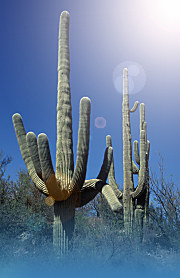
Contents: NWS
Layout: F. Geller-Grimm
Photos: © Krabbe-Paulduro

Survival Strategies of plants
Compared to tropical rain forests, deserts support relatively few species of plants. However, their variety is distinctively greater than one would expect at first sight. For example, there are more than 1,400 different plant species in the Saharan desert.
Securing the water supply as well as protection from intense sunrays and from being eaten are some of the most important factors, which limit life in the desert. Therefore, numerous plants have developed special adaptations and survival strategies:

